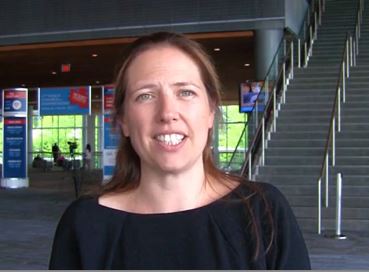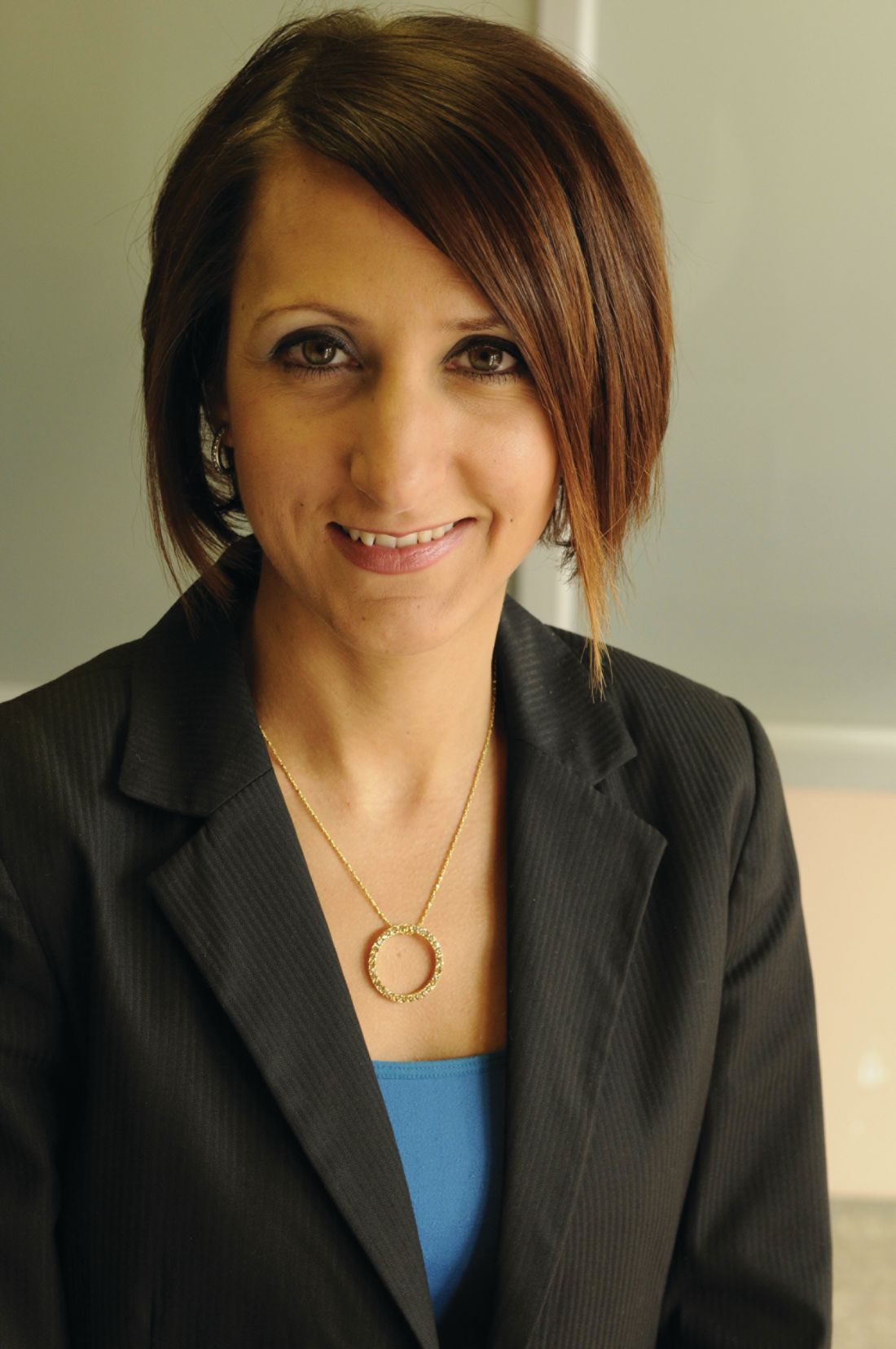User login
VIDEO: How to recognize, treat central sensitization in endometriosis
VANCOUVER – Sometimes in endometriosis, pain persists despite optimal treatment. Women have multiple lesion excisions, but the pain just doesn’t go away.
Evidence is building that in those cases, central sensitization – an amplified central nervous system pain response common in chronic pain syndromes – is playing a role.
In a video interview at the World Congress on Endometriosis, Katy Vincent, DPhil, MBBS, a senior pain fellow and consultant gynecologist at the University of Oxford, England, explained the latest thinking, as well as how to recognize and treat central sensitization in endometriosis. For some women, focusing on lesions isn’t enough.
The video associated with this article is no longer available on this site. Please view all of our videos on the MDedge YouTube channel
VANCOUVER – Sometimes in endometriosis, pain persists despite optimal treatment. Women have multiple lesion excisions, but the pain just doesn’t go away.
Evidence is building that in those cases, central sensitization – an amplified central nervous system pain response common in chronic pain syndromes – is playing a role.
In a video interview at the World Congress on Endometriosis, Katy Vincent, DPhil, MBBS, a senior pain fellow and consultant gynecologist at the University of Oxford, England, explained the latest thinking, as well as how to recognize and treat central sensitization in endometriosis. For some women, focusing on lesions isn’t enough.
The video associated with this article is no longer available on this site. Please view all of our videos on the MDedge YouTube channel
VANCOUVER – Sometimes in endometriosis, pain persists despite optimal treatment. Women have multiple lesion excisions, but the pain just doesn’t go away.
Evidence is building that in those cases, central sensitization – an amplified central nervous system pain response common in chronic pain syndromes – is playing a role.
In a video interview at the World Congress on Endometriosis, Katy Vincent, DPhil, MBBS, a senior pain fellow and consultant gynecologist at the University of Oxford, England, explained the latest thinking, as well as how to recognize and treat central sensitization in endometriosis. For some women, focusing on lesions isn’t enough.
The video associated with this article is no longer available on this site. Please view all of our videos on the MDedge YouTube channel
EXPERT ANALYSIS FROM THE WORLD CONGRESS ON ENDOMETRIOSIS
VIDEO: When to offer hysterectomy in endometriosis
VANCOUVER – Although hysterectomy will never again be the go-to treatment for endometriosis that it once was, it has become clear in recent years that it still has a role to play.
In a video interview at the World Congress on Endometriosis, Ray Garry, MD, a recently retired professor of obstetrics and gynecology at the University of Western Australia, Perth, explained why – in a limited way – the pendulum is swinging back toward hysterectomy for a select group of women.
The video associated with this article is no longer available on this site. Please view all of our videos on the MDedge YouTube channel
VANCOUVER – Although hysterectomy will never again be the go-to treatment for endometriosis that it once was, it has become clear in recent years that it still has a role to play.
In a video interview at the World Congress on Endometriosis, Ray Garry, MD, a recently retired professor of obstetrics and gynecology at the University of Western Australia, Perth, explained why – in a limited way – the pendulum is swinging back toward hysterectomy for a select group of women.
The video associated with this article is no longer available on this site. Please view all of our videos on the MDedge YouTube channel
VANCOUVER – Although hysterectomy will never again be the go-to treatment for endometriosis that it once was, it has become clear in recent years that it still has a role to play.
In a video interview at the World Congress on Endometriosis, Ray Garry, MD, a recently retired professor of obstetrics and gynecology at the University of Western Australia, Perth, explained why – in a limited way – the pendulum is swinging back toward hysterectomy for a select group of women.
The video associated with this article is no longer available on this site. Please view all of our videos on the MDedge YouTube channel
EXPERT ANALYSIS FROM THE WORLD CONGRESS ON ENDOMETRIOSIS
Interdisciplinary care reduces deep dyspareunia in endometriosis
VANCOUVER – Interdisciplinary care for women with deep dyspareunia led to a reduction in severe cases, but had no effect on superficial dyspareunia, a study showed.
The findings were measured after 1 year in a treatment program that included laparoscopic surgery, hormonal suppression, biofeedback, pelvic floor physiotherapy, cognitive-behavioral therapy, and mindfulness-based therapy.
About half of women with endometriosis experience deep dyspareunia, which can have a strong, negative impact on quality of life and relationships, Paul Yong, MD, PhD, reported at the World Congress on Endometriosis. For women who do not respond to surgical or medical interventions, interdisciplinary approaches that address the biopsychosocial aspect of pain in endometriosis could be of benefit, he said.
He said the researchers didn’t expect the superficial dyspareunia to respond to the treatments, since it is likely tied to nerve issues. But as a secondary measure, superficial dyspareunia acted as a sort of built-in control to show that the interventions were not having a broad placebo or nonspecific effect on pain.
The study included 296 women who came to the BC Women’s Hospital Centre for Pelvic Pain and Endometriosis with complaints of deep dyspareunia between December 2013 and December 2014. In total, 58% had a confirmed diagnosis of endometriosis, 24% had suspected endometriosis, and 18% had no endometriosis. More than half of the women had irritable bowel syndrome, 42% had painful bladder syndrome, and 30% had pelvic floor dysfunction.
About 55% of patients underwent surgery, while 13% were on hormonal treatment at both baseline and 1 year, 11% were on a pain adjuvant, 30% were on opioids, and 17% were enrolled in a pain program.
At baseline, half of the women reported severe symptoms of deep dyspareunia, but that percentage dropped to 30.4% at 1 year. Moderate cases increased from 17.7% at baseline to 25.0% at 1 year, and mild cases increased from 27.3% to 44.6% (P less than .0001).
A secondary analysis of patients with superficial dyspareunia showed no statistically significant changes in category frequencies. Severe cases represented 22.4% of the population at baseline and 20.2% at 1 year, and similarities were also seen in proportions of moderate (20.2% vs. 19.8%) and mild cases (57.4% vs. 60.1%, P = .65).
“This really suggests that the treatment program has some specificity for deep dyspareunia,” Dr. Yong said.
Depressive symptoms at baseline, as assessed by the Patient Health Questionnaire–9 scale, predicted deep dyspareunia at 1 year (odds ratio, 1.07; 95% confidence interval, 1.03-1.11).
The efficacy against deep dyspareunia is encouraging, but superficial dyspareunia is also a key concern.
“The study suggests that the typical treatments for endometriosis may not impact at all this really prevalent issue of superficial pain, so there’s more for us to do there because that can be a cause of long-term suffering and decreased quality of life,” said Lori Brotto, PhD, director of the sexual health laboratory at the University of British Columbia, who moderated the session during which the research was presented.
Dr. Yong called for more research, specifically a trial targeting treatment of depressive symptoms to determine any effect on endometriosis-related sexual pain or function.
“I think there needs to be more work in the role of depression – not only screening for depression in women with endometriosis, but trying to understand what role it plays in endometriosis symptoms,” Dr. Yong said.
The study was funded by the Canadian Institutes of Health Research. Dr. Yong and Dr. Brotto reported having no relevant financial disclosures.
VANCOUVER – Interdisciplinary care for women with deep dyspareunia led to a reduction in severe cases, but had no effect on superficial dyspareunia, a study showed.
The findings were measured after 1 year in a treatment program that included laparoscopic surgery, hormonal suppression, biofeedback, pelvic floor physiotherapy, cognitive-behavioral therapy, and mindfulness-based therapy.
About half of women with endometriosis experience deep dyspareunia, which can have a strong, negative impact on quality of life and relationships, Paul Yong, MD, PhD, reported at the World Congress on Endometriosis. For women who do not respond to surgical or medical interventions, interdisciplinary approaches that address the biopsychosocial aspect of pain in endometriosis could be of benefit, he said.
He said the researchers didn’t expect the superficial dyspareunia to respond to the treatments, since it is likely tied to nerve issues. But as a secondary measure, superficial dyspareunia acted as a sort of built-in control to show that the interventions were not having a broad placebo or nonspecific effect on pain.
The study included 296 women who came to the BC Women’s Hospital Centre for Pelvic Pain and Endometriosis with complaints of deep dyspareunia between December 2013 and December 2014. In total, 58% had a confirmed diagnosis of endometriosis, 24% had suspected endometriosis, and 18% had no endometriosis. More than half of the women had irritable bowel syndrome, 42% had painful bladder syndrome, and 30% had pelvic floor dysfunction.
About 55% of patients underwent surgery, while 13% were on hormonal treatment at both baseline and 1 year, 11% were on a pain adjuvant, 30% were on opioids, and 17% were enrolled in a pain program.
At baseline, half of the women reported severe symptoms of deep dyspareunia, but that percentage dropped to 30.4% at 1 year. Moderate cases increased from 17.7% at baseline to 25.0% at 1 year, and mild cases increased from 27.3% to 44.6% (P less than .0001).
A secondary analysis of patients with superficial dyspareunia showed no statistically significant changes in category frequencies. Severe cases represented 22.4% of the population at baseline and 20.2% at 1 year, and similarities were also seen in proportions of moderate (20.2% vs. 19.8%) and mild cases (57.4% vs. 60.1%, P = .65).
“This really suggests that the treatment program has some specificity for deep dyspareunia,” Dr. Yong said.
Depressive symptoms at baseline, as assessed by the Patient Health Questionnaire–9 scale, predicted deep dyspareunia at 1 year (odds ratio, 1.07; 95% confidence interval, 1.03-1.11).
The efficacy against deep dyspareunia is encouraging, but superficial dyspareunia is also a key concern.
“The study suggests that the typical treatments for endometriosis may not impact at all this really prevalent issue of superficial pain, so there’s more for us to do there because that can be a cause of long-term suffering and decreased quality of life,” said Lori Brotto, PhD, director of the sexual health laboratory at the University of British Columbia, who moderated the session during which the research was presented.
Dr. Yong called for more research, specifically a trial targeting treatment of depressive symptoms to determine any effect on endometriosis-related sexual pain or function.
“I think there needs to be more work in the role of depression – not only screening for depression in women with endometriosis, but trying to understand what role it plays in endometriosis symptoms,” Dr. Yong said.
The study was funded by the Canadian Institutes of Health Research. Dr. Yong and Dr. Brotto reported having no relevant financial disclosures.
VANCOUVER – Interdisciplinary care for women with deep dyspareunia led to a reduction in severe cases, but had no effect on superficial dyspareunia, a study showed.
The findings were measured after 1 year in a treatment program that included laparoscopic surgery, hormonal suppression, biofeedback, pelvic floor physiotherapy, cognitive-behavioral therapy, and mindfulness-based therapy.
About half of women with endometriosis experience deep dyspareunia, which can have a strong, negative impact on quality of life and relationships, Paul Yong, MD, PhD, reported at the World Congress on Endometriosis. For women who do not respond to surgical or medical interventions, interdisciplinary approaches that address the biopsychosocial aspect of pain in endometriosis could be of benefit, he said.
He said the researchers didn’t expect the superficial dyspareunia to respond to the treatments, since it is likely tied to nerve issues. But as a secondary measure, superficial dyspareunia acted as a sort of built-in control to show that the interventions were not having a broad placebo or nonspecific effect on pain.
The study included 296 women who came to the BC Women’s Hospital Centre for Pelvic Pain and Endometriosis with complaints of deep dyspareunia between December 2013 and December 2014. In total, 58% had a confirmed diagnosis of endometriosis, 24% had suspected endometriosis, and 18% had no endometriosis. More than half of the women had irritable bowel syndrome, 42% had painful bladder syndrome, and 30% had pelvic floor dysfunction.
About 55% of patients underwent surgery, while 13% were on hormonal treatment at both baseline and 1 year, 11% were on a pain adjuvant, 30% were on opioids, and 17% were enrolled in a pain program.
At baseline, half of the women reported severe symptoms of deep dyspareunia, but that percentage dropped to 30.4% at 1 year. Moderate cases increased from 17.7% at baseline to 25.0% at 1 year, and mild cases increased from 27.3% to 44.6% (P less than .0001).
A secondary analysis of patients with superficial dyspareunia showed no statistically significant changes in category frequencies. Severe cases represented 22.4% of the population at baseline and 20.2% at 1 year, and similarities were also seen in proportions of moderate (20.2% vs. 19.8%) and mild cases (57.4% vs. 60.1%, P = .65).
“This really suggests that the treatment program has some specificity for deep dyspareunia,” Dr. Yong said.
Depressive symptoms at baseline, as assessed by the Patient Health Questionnaire–9 scale, predicted deep dyspareunia at 1 year (odds ratio, 1.07; 95% confidence interval, 1.03-1.11).
The efficacy against deep dyspareunia is encouraging, but superficial dyspareunia is also a key concern.
“The study suggests that the typical treatments for endometriosis may not impact at all this really prevalent issue of superficial pain, so there’s more for us to do there because that can be a cause of long-term suffering and decreased quality of life,” said Lori Brotto, PhD, director of the sexual health laboratory at the University of British Columbia, who moderated the session during which the research was presented.
Dr. Yong called for more research, specifically a trial targeting treatment of depressive symptoms to determine any effect on endometriosis-related sexual pain or function.
“I think there needs to be more work in the role of depression – not only screening for depression in women with endometriosis, but trying to understand what role it plays in endometriosis symptoms,” Dr. Yong said.
The study was funded by the Canadian Institutes of Health Research. Dr. Yong and Dr. Brotto reported having no relevant financial disclosures.
AT WCE 2017
Key clinical point:
Major finding: Severe cases of deep dyspareunia dropped from 50.0% to 30.4% at 1 year.
Data source: A retrospective analysis of 296 patients at a single center.
Disclosures: The study was funded by the Canadian Institutes of Health Research. Dr. Yong and Dr. Brotto reported having no relevant financial disclosures.
VIDEO: Use oil-based contrast for HSG fertility boost
VANCOUVER – Ongoing pregnancies and live births were substantially higher when oil-based contrast, instead of water-based contrast, was used for hysterosalpingography (HSG) in a randomized trial at 27 hospitals in the Netherlands.
It’s long been known that HSG, commonly used to assess reproductive tract patency, also improves fertility, perhaps by immunologic effects or simply by flushing debris and mucus out of the fallopian tubes. Until now, however, it’s been unclear if oil or water contrast boosts fertility the most.
To find out, investigators randomized 554 infertile women scheduled for HSG to poppy seed oil contrast (Lipiodol Ultra-Fluid, Guerbet) and 554 others to water contrast (Telebrix Hystero, Guerbet).
A total of 220 women in the oil group (39.7%), but 161 in the water group (29.1%), achieved ongoing pregnancies (rate ratio in favor of oil, 1.37; 95% CI, 1.16-1.61; P less than 0.001). Of 552 women in each of the groups, 214 in the oil group (38.8%) and 155 in the water group (28.1%) had live births (RR, 1.38; 95% CI, 1.17-1.64; P less than 0.001). Rates of adverse events were low and similar in the two groups. About three-quarters of the pregnancies were naturally conceived, and most of the rest resulted from intrauterine insemination. Only a few women in each group used in vitro fertilization (N Engl J Med. 2017 May 18. doi: 10.1056/NEJMoa1612337).
Three women in the oil group, but none in the water group, delivered a child with a congenital anomaly. “This finding is probably due to chance. The frequency of congenital anomalies with oil contrast was not greater than rates reported in the general population, and we are unaware of other data suggesting an increased risk of congenital anomalies with oil contrast,” the researchers said.
In an interview at the World Congress on Endometriosis, senior investigator Ben Mol, MD, PhD, a professor of obstetrics and gynecology at the University of Adelaide (Australia), shared his thoughts on how the new findings should be used in routine practice when women with endometriosis and other conditions experience difficulty conceiving.
There was no industry funding for the work. Dr. Mol reported personal fees from Guerbet unrelated to the study.
The video associated with this article is no longer available on this site. Please view all of our videos on the MDedge YouTube channel
VANCOUVER – Ongoing pregnancies and live births were substantially higher when oil-based contrast, instead of water-based contrast, was used for hysterosalpingography (HSG) in a randomized trial at 27 hospitals in the Netherlands.
It’s long been known that HSG, commonly used to assess reproductive tract patency, also improves fertility, perhaps by immunologic effects or simply by flushing debris and mucus out of the fallopian tubes. Until now, however, it’s been unclear if oil or water contrast boosts fertility the most.
To find out, investigators randomized 554 infertile women scheduled for HSG to poppy seed oil contrast (Lipiodol Ultra-Fluid, Guerbet) and 554 others to water contrast (Telebrix Hystero, Guerbet).
A total of 220 women in the oil group (39.7%), but 161 in the water group (29.1%), achieved ongoing pregnancies (rate ratio in favor of oil, 1.37; 95% CI, 1.16-1.61; P less than 0.001). Of 552 women in each of the groups, 214 in the oil group (38.8%) and 155 in the water group (28.1%) had live births (RR, 1.38; 95% CI, 1.17-1.64; P less than 0.001). Rates of adverse events were low and similar in the two groups. About three-quarters of the pregnancies were naturally conceived, and most of the rest resulted from intrauterine insemination. Only a few women in each group used in vitro fertilization (N Engl J Med. 2017 May 18. doi: 10.1056/NEJMoa1612337).
Three women in the oil group, but none in the water group, delivered a child with a congenital anomaly. “This finding is probably due to chance. The frequency of congenital anomalies with oil contrast was not greater than rates reported in the general population, and we are unaware of other data suggesting an increased risk of congenital anomalies with oil contrast,” the researchers said.
In an interview at the World Congress on Endometriosis, senior investigator Ben Mol, MD, PhD, a professor of obstetrics and gynecology at the University of Adelaide (Australia), shared his thoughts on how the new findings should be used in routine practice when women with endometriosis and other conditions experience difficulty conceiving.
There was no industry funding for the work. Dr. Mol reported personal fees from Guerbet unrelated to the study.
The video associated with this article is no longer available on this site. Please view all of our videos on the MDedge YouTube channel
VANCOUVER – Ongoing pregnancies and live births were substantially higher when oil-based contrast, instead of water-based contrast, was used for hysterosalpingography (HSG) in a randomized trial at 27 hospitals in the Netherlands.
It’s long been known that HSG, commonly used to assess reproductive tract patency, also improves fertility, perhaps by immunologic effects or simply by flushing debris and mucus out of the fallopian tubes. Until now, however, it’s been unclear if oil or water contrast boosts fertility the most.
To find out, investigators randomized 554 infertile women scheduled for HSG to poppy seed oil contrast (Lipiodol Ultra-Fluid, Guerbet) and 554 others to water contrast (Telebrix Hystero, Guerbet).
A total of 220 women in the oil group (39.7%), but 161 in the water group (29.1%), achieved ongoing pregnancies (rate ratio in favor of oil, 1.37; 95% CI, 1.16-1.61; P less than 0.001). Of 552 women in each of the groups, 214 in the oil group (38.8%) and 155 in the water group (28.1%) had live births (RR, 1.38; 95% CI, 1.17-1.64; P less than 0.001). Rates of adverse events were low and similar in the two groups. About three-quarters of the pregnancies were naturally conceived, and most of the rest resulted from intrauterine insemination. Only a few women in each group used in vitro fertilization (N Engl J Med. 2017 May 18. doi: 10.1056/NEJMoa1612337).
Three women in the oil group, but none in the water group, delivered a child with a congenital anomaly. “This finding is probably due to chance. The frequency of congenital anomalies with oil contrast was not greater than rates reported in the general population, and we are unaware of other data suggesting an increased risk of congenital anomalies with oil contrast,” the researchers said.
In an interview at the World Congress on Endometriosis, senior investigator Ben Mol, MD, PhD, a professor of obstetrics and gynecology at the University of Adelaide (Australia), shared his thoughts on how the new findings should be used in routine practice when women with endometriosis and other conditions experience difficulty conceiving.
There was no industry funding for the work. Dr. Mol reported personal fees from Guerbet unrelated to the study.
The video associated with this article is no longer available on this site. Please view all of our videos on the MDedge YouTube channel
AT WEC 2017
Sexual dysfunction, depression common in endometriosis patients
VANCOUVER – Endometriosis is associated with an increased risk of a range of sexual dysfunctions, and depression and anxiety are also common, according to a study conducted in Brazilian women.
Depression and anxiety were so common that the study itself had to be altered. Almost a third of participants were excluded from the study due to depressive symptoms. So many, in fact, that the researchers decided to include patients with mild to moderate depression and anxiety, and ultimately exclude only those with severe symptoms.
The final sample included 254 women with endometriosis and 329 control subjects between 18 and 45 years old. They all had an active sex life in the previous 6 months, and were heterosexual.
Forty-three percent of women in the endometriosis group had sexual dysfunction, compared with 18% in the control group (P less than .001), as measured by the Female Sexual Quotient. They also had higher rates of individual types of sexual dysfunction, including sexual desire dysfunction (25% vs. 16%; P = .007); sexual arousal dysfunction (16% vs. 4%; P less than .001); pain during intercourse/sex dysfunction (46% vs. 16%; P less than .001); and orgasm and/or sexual satisfaction dysfunction (30% vs. 13%; P less than .001).
The researchers also examined the relationship between sexual dysfunction and psychological factors, and found statistically significant positive associations with anxiety and depression.
The underlying psychological issues are of particular concern to Dr. Fairbanks. “It’s the main step to begin anything with them. We have to know if they have anxiety and depression or not,” she said.
Her team now asks patients with endometriosis about their sex life in order to establish a baseline that can be referred to. “After 1 year, 2 years, 5 years, we reapply the questionnaire to show them that their sexual life was not so good in the beginning.”
The study was eye-opening to Lori Brotto, PhD, professor of gynecology at the University of British Columbia, Vancouver, who was a discussant at the session. “The call to action is for doctors to really pay attention to sexual dysfunction, even though that might not be the primary issue that brings the patient to them,” Dr. Brotto said.
The high rates of depression and anxiety also suggest a need for a more rounded approach to endometriosis treatment. “A physician may think, ‘we’ll treat the endometriosis, and all other parts of her should improve as well.’ This study suggests that primarily physical interventions may not be sufficient for addressing something like sexual health, which is really mind and body together,” said Dr. Brotto.
The study was not funded. Dr. Fairbanks and Dr. Brotto reported having no relevant financial disclosures.
VANCOUVER – Endometriosis is associated with an increased risk of a range of sexual dysfunctions, and depression and anxiety are also common, according to a study conducted in Brazilian women.
Depression and anxiety were so common that the study itself had to be altered. Almost a third of participants were excluded from the study due to depressive symptoms. So many, in fact, that the researchers decided to include patients with mild to moderate depression and anxiety, and ultimately exclude only those with severe symptoms.
The final sample included 254 women with endometriosis and 329 control subjects between 18 and 45 years old. They all had an active sex life in the previous 6 months, and were heterosexual.
Forty-three percent of women in the endometriosis group had sexual dysfunction, compared with 18% in the control group (P less than .001), as measured by the Female Sexual Quotient. They also had higher rates of individual types of sexual dysfunction, including sexual desire dysfunction (25% vs. 16%; P = .007); sexual arousal dysfunction (16% vs. 4%; P less than .001); pain during intercourse/sex dysfunction (46% vs. 16%; P less than .001); and orgasm and/or sexual satisfaction dysfunction (30% vs. 13%; P less than .001).
The researchers also examined the relationship between sexual dysfunction and psychological factors, and found statistically significant positive associations with anxiety and depression.
The underlying psychological issues are of particular concern to Dr. Fairbanks. “It’s the main step to begin anything with them. We have to know if they have anxiety and depression or not,” she said.
Her team now asks patients with endometriosis about their sex life in order to establish a baseline that can be referred to. “After 1 year, 2 years, 5 years, we reapply the questionnaire to show them that their sexual life was not so good in the beginning.”
The study was eye-opening to Lori Brotto, PhD, professor of gynecology at the University of British Columbia, Vancouver, who was a discussant at the session. “The call to action is for doctors to really pay attention to sexual dysfunction, even though that might not be the primary issue that brings the patient to them,” Dr. Brotto said.
The high rates of depression and anxiety also suggest a need for a more rounded approach to endometriosis treatment. “A physician may think, ‘we’ll treat the endometriosis, and all other parts of her should improve as well.’ This study suggests that primarily physical interventions may not be sufficient for addressing something like sexual health, which is really mind and body together,” said Dr. Brotto.
The study was not funded. Dr. Fairbanks and Dr. Brotto reported having no relevant financial disclosures.
VANCOUVER – Endometriosis is associated with an increased risk of a range of sexual dysfunctions, and depression and anxiety are also common, according to a study conducted in Brazilian women.
Depression and anxiety were so common that the study itself had to be altered. Almost a third of participants were excluded from the study due to depressive symptoms. So many, in fact, that the researchers decided to include patients with mild to moderate depression and anxiety, and ultimately exclude only those with severe symptoms.
The final sample included 254 women with endometriosis and 329 control subjects between 18 and 45 years old. They all had an active sex life in the previous 6 months, and were heterosexual.
Forty-three percent of women in the endometriosis group had sexual dysfunction, compared with 18% in the control group (P less than .001), as measured by the Female Sexual Quotient. They also had higher rates of individual types of sexual dysfunction, including sexual desire dysfunction (25% vs. 16%; P = .007); sexual arousal dysfunction (16% vs. 4%; P less than .001); pain during intercourse/sex dysfunction (46% vs. 16%; P less than .001); and orgasm and/or sexual satisfaction dysfunction (30% vs. 13%; P less than .001).
The researchers also examined the relationship between sexual dysfunction and psychological factors, and found statistically significant positive associations with anxiety and depression.
The underlying psychological issues are of particular concern to Dr. Fairbanks. “It’s the main step to begin anything with them. We have to know if they have anxiety and depression or not,” she said.
Her team now asks patients with endometriosis about their sex life in order to establish a baseline that can be referred to. “After 1 year, 2 years, 5 years, we reapply the questionnaire to show them that their sexual life was not so good in the beginning.”
The study was eye-opening to Lori Brotto, PhD, professor of gynecology at the University of British Columbia, Vancouver, who was a discussant at the session. “The call to action is for doctors to really pay attention to sexual dysfunction, even though that might not be the primary issue that brings the patient to them,” Dr. Brotto said.
The high rates of depression and anxiety also suggest a need for a more rounded approach to endometriosis treatment. “A physician may think, ‘we’ll treat the endometriosis, and all other parts of her should improve as well.’ This study suggests that primarily physical interventions may not be sufficient for addressing something like sexual health, which is really mind and body together,” said Dr. Brotto.
The study was not funded. Dr. Fairbanks and Dr. Brotto reported having no relevant financial disclosures.
AT WCE 2017
Key clinical point: Sexual dysfunction is common but not always addressed by clinicians.
Major finding: Women with endometriosis had more than doubled risk of sexual dysfunction.
Data source: Forty-three percent of the endometriosis group had dysfunction, compared with 17.6% of controls.
Disclosures: The study was not funded. Dr. Fairbanks and Dr. Brotto reported having no relevant financial disclosures.






